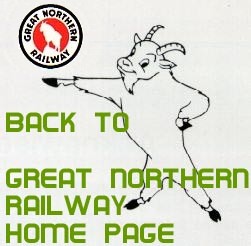|


| |
GN Electric Operations continued
Passenger trains, for observation. Be sure to make trips on
both Westinghouse and General Electric locomotives, for
you are liable to get either kind on any run.
After engineer makes several observation trips with regular
crews, he will be accompanied by Asst. Master Mechanic
in charge of operation and under his supervision the
student engineer will change places with regular man and
be given his turn at the controls. On completion of a
satisfactory number of trips (depending on man himself)
under supervision, men will be okayed for electric service.
For the first few pay trips they will see that Asst. Master
Mechanic in charge is notified in time to accompany them
over the road as an added precaution. Re-qualification is
necessary when away from electrical zone six months.
(d) Firemen, following their preliminary shop instruction,
will make student trips on road with regular crew and
learn the routine of making rounds every fifteen or twenty
minutes through the units and reporting to engineer each
time, OK if all is well and advising him if anything is
heating up around motor generator sets, bearings, resistor
units, tires or pantograph shoes torn up striking anything
on overhead system. In line with winter service, firemen
will make student trips on through trains to familiarize
themselves with heater cars. No extra firemen should take
a passenger call in cold weather unless familiar with
heater cars. The proper marking up of K. W. H. meter charts
at beginning and end of each run is very important,
particularly the date at end of run. Firemen will be okayed
at completion of student trips by Foreman or Asst. Master
Mechanic. Re-qualification is necessary when away from
electrical zone six months.
Electric Locomotive KWH Meter Charts
The electric locomotives are equipped with KWH meters
which register the motoring and regeneration KWH. Meter
charts for recording this data are supplied each cab.
Firemen will mark the meter charts as follows: At exact
point where the indicating pointers are, mark the outside
of all dials going out on a trip, and mark the inside of all
dials at end of a trip. Date chart on arrival date at end
of trip. Fill in all the data called for on the chart itself,
and sign chart. There are five dials on each meter and two
meters on each cab. The General Electric meters are equipped
with vertical located dials with the smallest reading
at top and largest reading dial at bottom. The Westinghouse
have five dials also, with the lowest reading one on
Page 5
a big circle enclosing the other four, of which the left hand
one is highest reading dial. Do not leave out any information
and use care in marking meter charts accurately.
Every cab movement must have a fully completed and
filled out meter chart, and even if no power is used firemen
will mark charts inside and outside dials, fill in all
information and write across chart "Towed dead from Station
A to Station B."
When crews are relieved on road they will complete their
charts fully at that point and sign them. The relief crew
will make out new charts from that point in to end of run.
Both crews to write particulars across face of charts such
as "No. 402 relieved at Station A." "Relieved No. 402 at
Station A."
If one cab of a series is shut down at any point between
terminals, indicate same in writing across chart, such as
"5006-B towed dead Berne to Wenatchee."
Report any erratic action of meters at shop.
Data and Information for Electric Locomotive Crews
Visitors who are eligible to ride our electrics often ask
questions about them, which you ordinarily ought to know
if at all interested in your work.
Data: Locomotives 5000 to 5017.
Type of system: 11,000 volt, single phase, 25 cycle trolley.
Trolley construction: The inclined catenary type.
Locomotive type: Motor generator, taking the single phase
power at 11,000 volts A. C., transforming it inside
locomotive from 11,000 to (1,250 Westinghouse — 2,500
General Electric) for driving synchronous motor at 750
R.P.M. The synchronous motors drive D. C. generators
(General Electric 750 V. D. C. — Westinghouse 600
V.D.C.) which supply D. C. power to the traction motors
geared to the driving axles.
Locomotive ratings at full load —
General Electric 3,000 H.P. @ rail.
Westinghouse 2,000 H.P. @ rail.
The Motor Generator set ratings —
General Electric 2,500 KW Gen. output.
Westinghouse 1,500 KW Gen. output.
Tonnage capacity on 2.2% grade —
General Electric 1,000 tons. @ 18 M. P. H.
Westinghouse 750 tons @ 15 M. P. H.
Page 6
Locomotive weights — Total —
General Electric 260 tons.
Westinghouse 180 tons.
Locomotive weights — On drivers —
General Electric 414,000 lbs.
Westinghouse 275,000 lbs.
Top speeds —
General Electric 50 M. P. H.
Westinghouse 37 and 45 M. P. H.
Limited by armature banding.
Regeneration Tonnage Capacity on 2.2% grade —
General Electric 1,400 tons @ 18 M. P. H.
Westinghouse 1,250 tons @ 15 M. P'. H.
Proximate cost per cab —
General Electric $250,000.00.
Westinghouse $150,000.00.
Difference in Metering Systems Between General Electric
And Westinghouse
The General Electric locomotives are metered as follows:
A. C. voltmeter is on the main transformer secondary
and indicates about 2,500 volts synchronous motor when
the trolley voltage is 11,000 volts.
Synchronous ampere meter measures the current flowing
to the synchronous motor. It is operated by a current
transformer.
The balancing voltmeter D. C., is really a differential
connected meter between the D. C. generator and the traction
motors when locomotive is being put into regeneration.
The generator voltage drives meter hand to right, or low
indication, while regenerated traction voltage during the
transition from motoring to regeneration drives the hand
back from low toward high zone to zero, at which point
locomotive is automatically in regeneration.
The D. C. traction meters, armature and field amperes
are operated by meter shunts in the one motor group
comprising No. 1 and No. 2 motors. These meters indicate the
D. C. amperes per motor group, and as there are three
parallel groups of two motors in series, the D. C. amperes
indicated is one third of what the generators are actually
putting out. Cutting out No. 1 and No. 2 motors means
no D. C. meters to run with.
Page 7
The Westinghouse locomotive meters are hooked up as
follows:
The line voltmeter indicates trolley voltage, 11,000 volts,
and is operated by an 11,000 to 110 volt potential
transformer across main transformer primary.
The synchronous ampere meter is operated by a current
transformer in synchronous motor circuit and indicates
current flowing to synchronous motor.
The balancing voltmeter D. C. is so connected that it
measures the voltage drop across a traction motor field;
likewise across a stabilizing switch. When putting
locomotive in separate field connection for higher speed or
regeneration, the regeneration exciter voltage builds up opposite
polarity to the field voltage drop, and when the two voltages
equalize or balance, engine may be put into separate
field control connection.
The D. C. traction meters, armature and field amperes
are connected to shunts in the generator output for armature
amperes, and the regenerative exciter output for field
amperes. They measure actual total amperes to the motors
and regardless of cutting out motors, they indicate total
amperes being supplied to motors in the circuit being used.
Preparing Electric Locomotives For Road Service
Connecting up air hose between cabs. Multiple unit
operation of two or three cabs requires that following
instructions be strictly observed.
All cabs are equipped with four hose connections on each
end, except the number one end of 5004-A, B, and 5006-A,
B. These connections are train line air brake hose and
regular train signal hose, on one side (left of bumper beam),
while on right side of bumper beam are located the main
reservoir hose, and the engine independent air brake hose.
All four hose must be properly connected between cabs,
and the angle cocks all properly cut in. Many serious
delays due to some angle cock not cut in result in mis-operation
of air brakes and runaway compressors, with resulting
damaged air gauges, overheated compressor motors, and
excess pressure on main reservoirs, relieved only by
continuous popping of safety valves. Do not rush when checking
up connections. Look and be sure that all hose are
properly connected and that all angle cocks are cut in.
If not sure the first time, check again. These connections
must all be right, or you are in for plenty of trouble. In
checking any circuit, air or electric, one man must check
Page 8
 
 
|